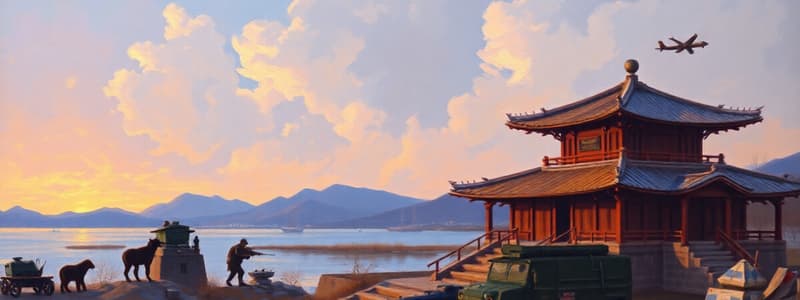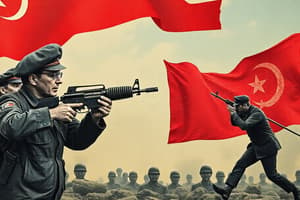Podcast
Questions and Answers
What was the main cause of the Korean War?
What was the main cause of the Korean War?
- The rise of communism in Japan
- The invasion of China by North Korea
- The United States' withdrawal from Korea
- The division of Korea after World War II (correct)
Which event marked the beginning of active hostilities in the Korean War?
Which event marked the beginning of active hostilities in the Korean War?
- The Inchon landing
- The Chinese intervention
- The surprise invasion by North Korea (correct)
- The signing of the Korean Armistice Agreement
What was the significance of the Inchon landing during the Korean War?
What was the significance of the Inchon landing during the Korean War?
- It was a successful amphibious operation that changed the war's momentum (correct)
- It prevented the entry of Chinese troops into Korea
- It marked the end of the war
- It resulted in the capture of the North Korean capital
Which factor significantly altered the course of the Korean War in late 1950?
Which factor significantly altered the course of the Korean War in late 1950?
What was a primary role of the Korean Demilitarized Zone (DMZ) established after the war?
What was a primary role of the Korean Demilitarized Zone (DMZ) established after the war?
What was the outcome of the armistice talks held in Panmunjeom/Kaesong?
What was the outcome of the armistice talks held in Panmunjeom/Kaesong?
How did the Cold War influence the Korean War?
How did the Cold War influence the Korean War?
Which statement best describes the public opinion in the United States regarding the Korean War?
Which statement best describes the public opinion in the United States regarding the Korean War?
Flashcards
What were the roots of the Korean War?
What were the roots of the Korean War?
The Korean War (1950-1953) originated from the division of Korea following World War II, with the Soviet Union administering the north and the United States administering the south. This division led to differing political ideologies and ultimately conflict, as North Korea under communist leadership aimed to unify the peninsula.
Describe the beginning of the Korean War.
Describe the beginning of the Korean War.
On June 25, 1950, North Korea launched a surprise invasion of South Korea, quickly overwhelming the poorly equipped South Korean forces. The United Nations Security Council, with the Soviet Union absent, condemned the invasion and authorized a military response. US-led forces, primarily American troops, were deployed to defend South Korea.
How did the tide of the war turn?
How did the tide of the war turn?
The initial North Korean advance pushed UN forces back to a small perimeter around the Pusan area. However, the Inchon landing, a daring amphibious operation, successfully reversed the war's momentum and pushed North Korean forces back.
What event drastically changed the war's direction?
What event drastically changed the war's direction?
Signup and view all the flashcards
How did the Cold War influence the Korean War?
How did the Cold War influence the Korean War?
Signup and view all the flashcards
How did public opinion and international pressure affect the war?
How did public opinion and international pressure affect the war?
Signup and view all the flashcards
Describe the outcome of the Korean War.
Describe the outcome of the Korean War.
Signup and view all the flashcards
What was the lasting impact of the Korean War?
What was the lasting impact of the Korean War?
Signup and view all the flashcards
Study Notes
Background and Causes
- The Korean War (1950-1953) originated from the division of Korea after World War II.
- The peninsula was split along the 38th parallel, with the Soviet Union controlling the north and the United States the south.
- These administrations created separate governments, fostering different political ideologies, ultimately causing conflict.
- North Korea, under communist leadership, sought to unify the Korean peninsula under its control.
Initial Stages of the War
- On June 25, 1950, North Korean forces launched a surprise attack on South Korea.
- The invasion quickly overwhelmed poorly equipped and inexperienced South Korean forces.
- The UN Security Council, absent Soviet representation, condemned the invasion and authorized a military response.
- US-led forces, primarily American troops, were sent to defend South Korea.
Key Military Events
- North Korea's initial advance pushed UN forces back to a small area around Pusan.
- The Inchon landing, a daring amphibious operation, dramatically shifted the war's momentum, pushing back North Korean forces.
- The Chinese intervention in late 1950 caught UN forces off guard, significantly altering the war's course. Chinese motivations stemmed from ideological and strategic concerns.
- Fighting intensified, with forces repeatedly crossing the 38th parallel.
- The war became a stalemate around the Korean Demilitarized Zone (DMZ), a highly fortified border roughly following the 38th parallel.
Political and International Factors
- The Cold War heavily influenced the conflict, serving as a proxy war between the US and the Soviet Union.
- China's participation broadened the conflict's global impact.
- Public opinion was divided within the participating nations during the war.
- Growing international pressure emphasized the need for an armistice to achieve peace.
Armistice and Aftermath
- Armistice negotiations, lasting over two years, took place in Panmunjeom/Kaesong, Korea.
- Political and ideological differences hampered peace efforts.
- The Korean Armistice Agreement, signed on July 27, 1953, halted active fighting but did not formally end the war.
- A Demilitarized Zone (DMZ) was established along the 38th parallel to separate the opposing sides.
- The Korean peninsula remained divided, with reunification efforts unsuccessful in the years since.
Impact and Legacy
- The Korean War caused immense human suffering, with numerous casualties and widespread infrastructure damage.
- The war severely escalated the Cold War, deeply impacting post-war global relations.
- The war solidified the division of Korea, leading to distinct political, social, and economic differences between the north and south.
- A heightened sense of militarism and an increase in global military spending followed the conflict.
Studying That Suits You
Use AI to generate personalized quizzes and flashcards to suit your learning preferences.




